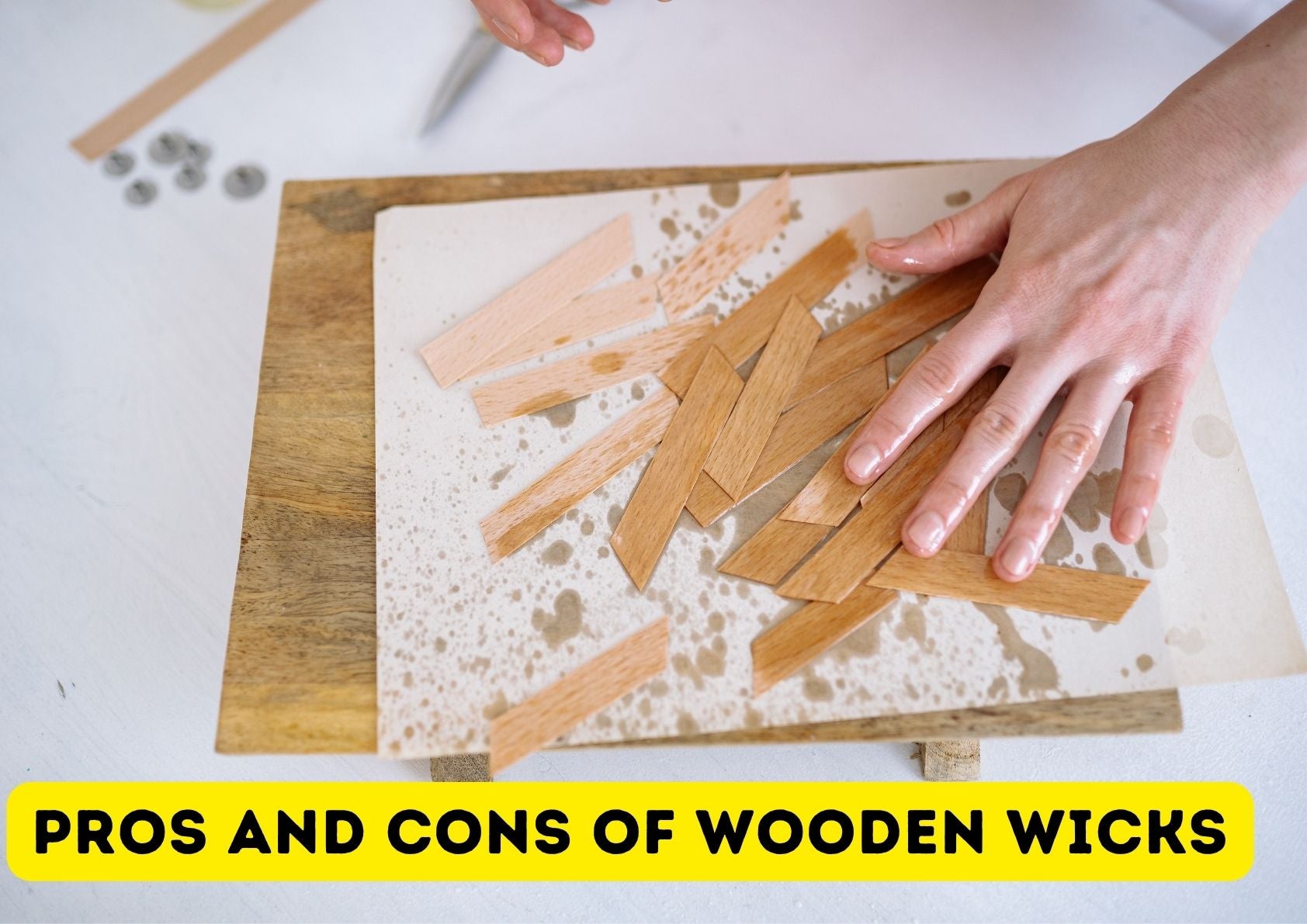Working with Different Types of Wood Wicks
Wooden wicks have increasingly grown in popularity over recent years with their beautiful crackling and unique properties. They’ve really become quite trendy and if you’re a candle maker yourself then you should think about using wood wicks in your candles to stand out from the crowd.
We’ll explore what exactly wood wicks are, the different types, and the benefits of using a wooden wick.

What are Wooden Wicks?
Before we explore the various types of wood wicks, let’s briefly discuss what they are. Wooden wicks are thin strips of wood used to make candles. They create this stunning crackling and unique flicker; however, it should be noted that they require a tad more attention and maintenance.
Wood wicks are usually centred in the wax and fuel the flame by wicking the wax. Wooden wicks are slightly pricier than cotton wicks. They each roughly cost the same price; an average of £0.50 per wick.
Pros & Cons of Wooden Wicks, Compared to Cotton & Linen Wicks:
-
Wooden wicks provide a longer and cleaner burn than cotton or linen wicks. They also create a crackling sound, similar to a wood fire, which can add to the ambiance of a room.
-
Wooden wicks are more eco-friendly than cotton or linen wicks, as they are made from sustainable wood sources and do not require pesticides or fertilizers.
-
Wooden wicks are also more heat-resistant than cotton or linen wicks, which means they are less likely to char or burn out quickly.
-
Wooden wicks can be used in a wider variety of candle types and fragrances, as they do not absorb the scent of the wax like cotton or linen wicks do.
-
Wooden wicks are more expensive than cotton or linen wicks, and may require special equipment or tools to properly prepare and use.
-
Wooden wicks can be more difficult to light, as they require more heat to get started, and may need to be trimmed more frequently to keep the candle burning properly.
-
Wooden wicks can produce more soot than cotton or linen wicks, which can discolor the candle or surrounding surfaces.
-
Overall, wooden wicks are a great option for those looking for a longer, cleaner burn, and a unique ambiance, but they do require more care and attention than cotton or linen wicks.

Types of Wood Wicks
There are three main different types of wood wicks; the single ply, booster, and spiral wick. Not all of them are the same and each is suited for different types of wax.
The main determinants for the success of your DIY candle are the width of the wick, the size of the holder. Another factor is whether or not the wick is compatible with the type of wax and fragrant load.
-
Single Ply Wick
The single ply wick is also known as the flat wick. It is the most common type of wood wick and it’s the thinnest type.
They don’t perform well in natural waxes, so it is best to use them in combination with non-natural waxes such as paraffin, parasoy or a coconut wax blend. You should stay away from waxes that hold excessive amounts of fragrance oil.
Typically, the single strip of wood is no more than 0.04 inches thick and 0.75 inches wide.
-
Booster Wick
This wooden wick is also referred to as the double wick, and it’s basically the same as the single ply wick. The major difference is that the booster wick has an extra strip attached in the middle of the main wick to make it thicker. This additional strip acts as a thermal output booster.
If you love a fragranced candle, then this wick is the ideal choice. It can handle waxes that hold a good amount of fragrance oil. The booster wick also has a low heat output. You have a good amount of wax choices when it comes to this wick; soy wax, bees wax, and palm wax.
-
Spiral Wick
The spiral wick is pretty unique, it has a hollow centre. It’s a delicate thin sheet of wood that has been wrapped into a spiral. The spiral wick is still made of authentic wood; however, it has just been manipulated.
The great thing about this specific wooden wick is that it works well in all types of waxes. It burns at a higher heat, creating a beautiful pool of wax. Not only is it unique in its look but the spiral wick burns an intricate teardrop-shaped flame. It adds a modern aesthetic to your home or even the patio.

-
Cross wooden candle wicks are a popular choice among candle makers for their unique look and crackling sound. These wicks are made from high-quality wood, typically from sustainable sources, and are designed to provide a longer and cleaner burn than traditional cotton or linen wicks. The unique cross shape of these wooden wicks also creates a unique visual effect in the candle, making it a popular choice for decoration or as a gift. Additionally, cross wooden candle wicks are eco-friendly as they don't require pesticides or fertilizers to grow. They are also heat resistant and can be used in a wide variety of candle types and fragrances, as they don't absorb the scent of the wax. Cross wooden candle wicks are more expensive than traditional cotton or linen wicks, but they offer a unique experience and can add a special touch to any candle.
Once you've decided on your wooden wick, you'll need to learn how to secure a wick in your candle jar.
The Benefits of Wooden Wicks
There’s plenty of reasons why the wood wick has become a favourable choice by consumers and candle makers alike. They’re sustainable, produce a clean burn, are long-lasting as well as create an amazing ambience.

Sustainable
A cotton wick has a bad reputation for having severe environmental demands. Cotton requires thousands of gallons of water and is chemically intensive. Wood wicks, however, are harvested using sustainable methods and many wicks can be produced from one tree.
The wood is totally toxin free which makes it even more eco-friendly. It’s always a great to enjoy those beautiful burns while knowing that you’re being environmentally friendly.
Clean Burn
All candle lovers have often been left with soot after the candle has burnt. They produce less carbon, sooty residue and less debris builds up. Wood wicks greatly reduce the amount of soot left over and they aren’t treated with anything to maintain a consistent burn. This makes for a much cleaner burn.
A cleaner burn means that your candles will produce a better flame. It will shine brighter and create a warm ambience.

Long-Lasting
Not only are these alluring wicks environmentally friendly and clean burning but they are long-lasting too. We all want to add a little more life to our candles to see that beautiful flame just that bit longer. Wooden wick candles extend your candle's life as they have a slower burn.
This means that your candles will last longer which is financially beneficial and purchasing fewer candles is also environmentally friendly.
Amazing Ambience
A wooden wick produces a stunning flame and sound that creates a great ambience. The crackling sound when burning coupled along with the calming, warm glow makes for a relaxing and cosy environment.
A wooden wick not only creates a calming vibe, but they have a modern aesthetic too. It has a horizontal flame that creates an almost modern feel to any room.
A wooden wick has this amazing ability to give off more fragrance which further adds to the ambience of your home. The wick diffuses more heat into the wax and throws more fragrance in a room compared to a cotton wick. This means that your wooden wick works quickly to spread the great smelling fragrance oil within the wax.
Conclusion
Wooden wicks are all the rage right now, and there’s no denying that these alluring wicks produce stunning flames. They may require a little more maintenance and attention, however, it’s definitely worth it.
When making your very own DIY wooden wick candle, keep in mind that the different types of wood wicks have varying properties and characteristics.



